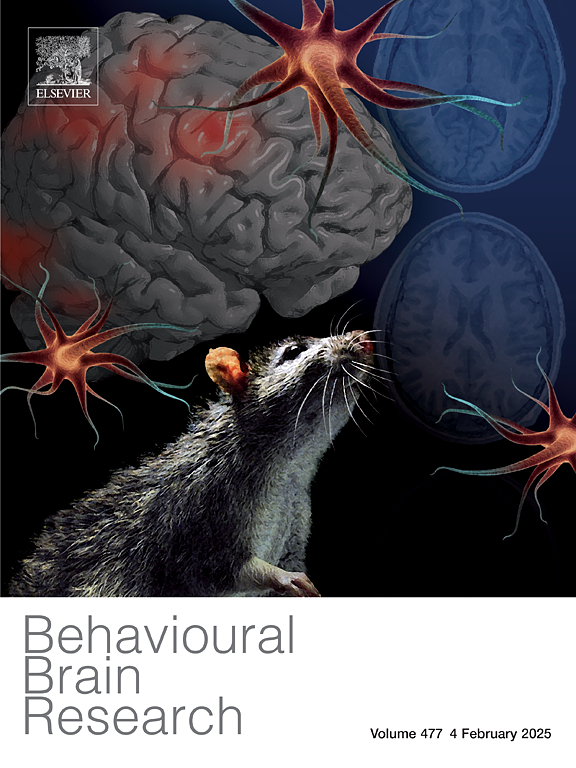MiR-29a-3p ameliorate behavioral deficiency in hypoxia-ischemia brain damage in neonatal mice by inhibiting BTG2
IF 2.6
3区 心理学
Q2 BEHAVIORAL SCIENCES
引用次数: 0
Abstract
It has been reported that miR-29a-3p played a part in series neurological disorders. However, it remains unclear whether miR-29a-3p participate in the pathological mechanism in hypoxia-ischemia (HI) brain injury. In this study, we detected the change of miR-29a-3p level in the ipsilateral cortex following HI brain injury and found that miR-29a-3p was significantly increased at 3 days in the ipsilateral cortex following HI insult in neonatal mice. Therefore, we further explored the role of miR-29a-3p in HI brain injury and its molecular mechanism. The results showed that miR-29a-3p mimics attenuated and miR-29a-3p antagomir aggravated brain infarction volume at 3 days following HI insult. We further found that overexpression of miR-29a-3p also suppressed apoptosis and neuroinflammation, reduced synaptic loss and prevent HI-induced microglial morphological changes 3 days following HI insult. Neurobehavioral tests revealed that overexpression of miR-29a-3p could improve both short-term and long-term behavioral defects after HI injury. Furthermore, we proved that miR-29a-3p targets B-cell translocation gene 2 (BTG2) and further inhibits the expression of Bax by luciferase reporter assay and qRT-PCR. Moreover, overexpression of miR-29a-3p, by applying liposomes through intranasal route, could also achieve the same therapeutic effect in HI injury. Our data showed that by inhibiting BTG2/Bax, increasing level of miR-29a-3p might serve as a strategy to prevent brain damage and behavioral deficiency in HI.
MiR-29a-3p通过抑制BTG2改善新生小鼠缺氧缺血脑损伤的行为缺陷。
有报道称,miR-29a-3p在一系列神经系统疾病中起作用。然而,miR-29a-3p是否参与缺氧缺血(hypoxia-ischemia, HI)脑损伤的病理机制尚不清楚。在本研究中,我们检测了HI脑损伤后同侧皮质miR-29a-3p水平的变化,发现新生儿小鼠HI脑损伤后第3天同侧皮质miR-29a-3p水平显著升高。因此,我们进一步探讨miR-29a-3p在HI脑损伤中的作用及其分子机制。结果显示,在HI损伤后3天,miR-29a-3p模拟物减弱,miR-29a-3p拮抗莫加重脑梗死体积。我们进一步发现,过表达miR-29a-3p还能抑制细胞凋亡和神经炎症,减少突触丢失,并防止HI损伤后3天HI诱导的小胶质细胞形态学改变。神经行为测试显示,过表达miR-29a-3p可以改善HI损伤后的短期和长期行为缺陷。此外,我们通过荧光素酶报告基因测定和qRT-PCR证明了miR-29a-3p靶向b细胞易位基因2 (BTG2),并进一步抑制Bax的表达。此外,通过鼻内给药脂质体过表达miR-29a-3p也可以达到同样的治疗HI损伤的效果。我们的数据表明,通过抑制BTG2/Bax, miR-29a-3p水平的升高可能是预防HI脑损伤和行为缺陷的一种策略。
本文章由计算机程序翻译,如有差异,请以英文原文为准。
求助全文
约1分钟内获得全文
求助全文
来源期刊

Behavioural Brain Research
医学-行为科学
CiteScore
5.60
自引率
0.00%
发文量
383
审稿时长
61 days
期刊介绍:
Behavioural Brain Research is an international, interdisciplinary journal dedicated to the publication of articles in the field of behavioural neuroscience, broadly defined. Contributions from the entire range of disciplines that comprise the neurosciences, behavioural sciences or cognitive sciences are appropriate, as long as the goal is to delineate the neural mechanisms underlying behaviour. Thus, studies may range from neurophysiological, neuroanatomical, neurochemical or neuropharmacological analysis of brain-behaviour relations, including the use of molecular genetic or behavioural genetic approaches, to studies that involve the use of brain imaging techniques, to neuroethological studies. Reports of original research, of major methodological advances, or of novel conceptual approaches are all encouraged. The journal will also consider critical reviews on selected topics.
 求助内容:
求助内容: 应助结果提醒方式:
应助结果提醒方式:


